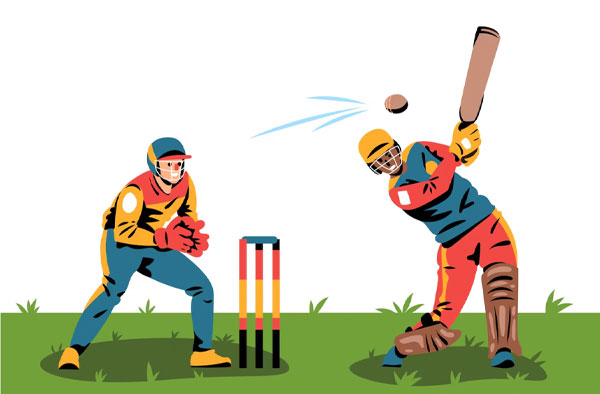The game of cricket revolves around the bat. The design and technology of this equipment have always been important for improving players’ skills. Materials and manufacturing processes have changed with time, resulting in stronger bats that are also more lasting and adaptable for players’ enjoyment. Such developments have had an impact not only on how well a bat performs but also on the game itself.

History of Change in Cricket Batting Equipment
Cricket bats started out as basic wooden paddles before they went through several modifications. Early designs consisted entirely of willow wood which was shaped like a hockey stick. Eventually, the blade became flat-fronted with a rounded back while handles were made from cane and rubber grips began to be used for better control over shots played by batsmen, especially against spin bowling.
During the 20th century, there was an increased focus on selecting better quality timber as well as refining production methods, which led to complex modern cricketing implements. For enthusiasts who appreciate these advancements in cricket equipment, engaging with cricket bets allows a deeper connection by betting on players wielding these modern bats.
Modern Materials and Construction Techniques
Nowadays, different types of advanced building materials are combined using various techniques to achieve maximum performance characteristics from cricket bats while maintaining their longevity at the same time. Here are some notable methods and materials employed:
- Reinforced carbon fiber (RCF): This is used so as not to make the bat too heavy but still provide additional strength where necessary.
- Composites: These help increase durability while enhancing elasticity properties, which enable them to withstand more forceful impacts without breaking easily, unlike traditional all-wood construction.
- Treatments applied on willow wood: There are new treatments that have been discovered over recent years which, when applied onto willow, make it stronger against moisture effects, hence improving its overall performance during use.
These advancements not only ensure a longer lifespan for these pieces of equipment but also aid adjustment toward the optimal balance point and weight distribution. Thus, they enable cricketers to hit the ball harder, making matches livelier and full of action.
Technology’s Influence on Batting Performance
Tools such as CAD or Computer-Aided Design and biomechanical analysis have revolutionized cricket bat-making. They make it possible to precisely optimize balance, weight distribution, and the sweet spot, thus greatly improving the performance of a bat in terms of power.
Personalization and Customisation
Modern technology allows cricket bats to be personalized according to individual players’ styles and preferences. Players can adjust their bats by adding or reducing weights for better balance between power and control that suits their strength, technique, or even weather conditions. The size of the custom grip ensures comfort in hands, which enhances control while reducing the chances of getting blisters.
This means every shot is more effective because it fits well into the player’s style. This approach enables one to fine-tune his equipment so that he can perform at his best based on specific needs during different games.
Streamlining for Aerodynamics
The aerodynamic aspect of cricket bat design greatly influences how a bat moves through the air as well as its impact on the ball after being hit by such an object. Hence modern-day bats have slight changes in shape which help them reduce air resistance so they can achieve higher speeds during swings. Moreover, some parts come with textured surfaces that facilitate airflow over them, hence reducing drag while allowing for faster swings.
Also, optimizing profiles ensures smooth passage through the air, thereby increasing both velocity and accuracy when hitting balls with these kinds of bats. Such improvements make gameplay more exciting since they result in harder-hitting abilities combined with accuracy levels which are beyond expectation.
Testing and Quality Assurance
To ensure that the new cricket bats are up to standard, many tests have to be conducted. These tests are meant to see that every bat is able to perform consistently well under different conditions. Some of the steps followed include:
- Laboratory testing: This involves doing several stress tests on the bats to check their weight distribution, balance point, and durability, especially when used in intense games.
- Player feedback loops: The professional players test these cricket bats in real game scenarios where they get a chance to provide necessary feedback concerning their performance and feel. This feedback helps designers adjust their designs accordingly.
Moreover, some manufacturers use advanced imaging technologies that enable them to see inside structures of these bats. This helps them identify any faults or defects that may affect its performance. It is through employing all these methods together that cricket bat makers can ensure not only meeting but also exceeding quality expectations while providing the best equipment for players.
Challenges and Controversies
However, modern cricket bat design has not been without challenges and controversies surrounding it. One major problem with current designs lies around certain regulations limiting the size and shape of bats. Such rules were put in place to keep the balance between ball and bat, hence ensuring fairness during competition. Nevertheless, some claim such laws suppress creativity besides restricting technological advancements.
Furthermore, others argue that traditional materials are less durable than new composites, which tend not to last long enough, according to traditionalists who still prefer willow wood over other forms. Therefore, striking a balance between tradition and innovation remains contentious within the cricket community, thereby affecting future directions taken by batmakers.
Conclusion
Advancements in technology have revolutionized cricket bat design, leading to improved performance levels among players. Over time, different changes have been made to these sticks, starting from olden times until now, whereby even more recent ones continue stretching boundaries within the sports industry. As they evolve, so does gameplay itself, becoming more dynamic and exciting for both participants and viewers alike.

Loves all things female cricket